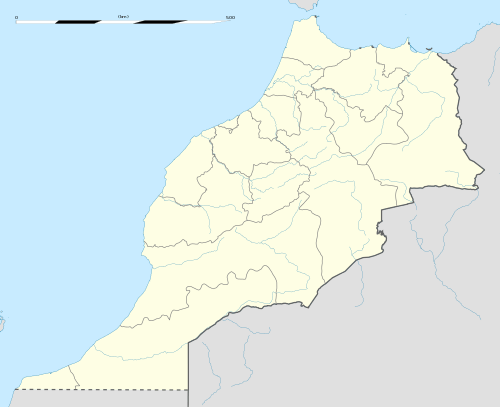Sidi Kacem
| Sidi Kacem سيدي قاسم | |
|---|---|
| Town | |
| Sidi Kacem, Morocco | |
 Sidi Kacem Location in Morocco | |
| Coordinates: 34°13′N 5°42′W / 34.217°N 5.700°WCoordinates: 34°13′N 5°42′W / 34.217°N 5.700°W | |
| Country |
|
| Region | Rabat-Salé-Kénitra |
| Province | Sidi Kacem |
| Government | |
| • Type | Mayor |
| • Mayor | El Hafed Mohamed |
| • Governor | Brahim Abouzeid |
| Elevation | 194 m (636.5 ft) |
| Population (2015) | |
| • Total | 90,000 |
| Time zone | WET (UTC+0) |
| • Summer (DST) | WEST (UTC+1) |
| Area code(s) | 212 |
Sidi Kacem (Arabic: سيدي قاسم, translit. Sidi 9sem) is a city in Rabat-Salé-Kénitra, Morocco. It is the capital of Sidi Kacem Province.
History
During the French period, it was called Petitjean, after a French captain who was killed in May 1911 during the "pacification" of Morocco. Oil drilling exploration commenced in the vicinity of Sidi Kacem by the French in 1934; production of crude oil began locally in 1939.[1]
Slightly to the south of Sidi Kacem, in antiquity, Volubilis was an important Roman town near the westernmost border of the Roman Empire. It was built on the site of a previous Carthaginian settlement from the third century BC, if not earlier.[2]
Weather
Summers are hot to very hot, highs clock between 32 °C (89.6 °F) and 36 °C (96.8 °F). Winters in the other hand are cold, and lows usually go beyond the freezing point. During the winter it rains with an average precipitation of 350 and 600 mm. It does not snow in Sidi Kacem.
Education
While there are no universities in Sidi Kacem, the only higher education available is in the Prince Moulay Abdellah Technical High School, where students can get a Higher Diploma in Electrical studies. Most Kacemians travel to Kenitra to attend Inb Tofial University, or other larger cities.
Transportation
Sidi Kacem's small taxis have fixed tolls depending on from where you are going and your destination. Add 50% of the toll at night.
Sidi Kacem is located on Morocco's national railway track, ONCF, which was considered as a crossroad, where passengers going to the North had to switch trains in its station. This is not longer the situation as the ONCF has constructed a direct railway which doesn't cross Sidi Kacem.
The town has a local buss station, which desserves all the regions of the country, in addition to multiple grand-taxis stations, for the nearest cities and villages.
Sites
- Sidi Kacem's tomb located in Zaouia.
- Oil refinery.
References
- ↑ British Petroleum Company, Our Industry, Petroleum: A Handbook, Published 1977, 600 pages
- ↑ C.Michael Hogan, Volubilis, Megalithic Portal, ed. A. Burnham (2007)